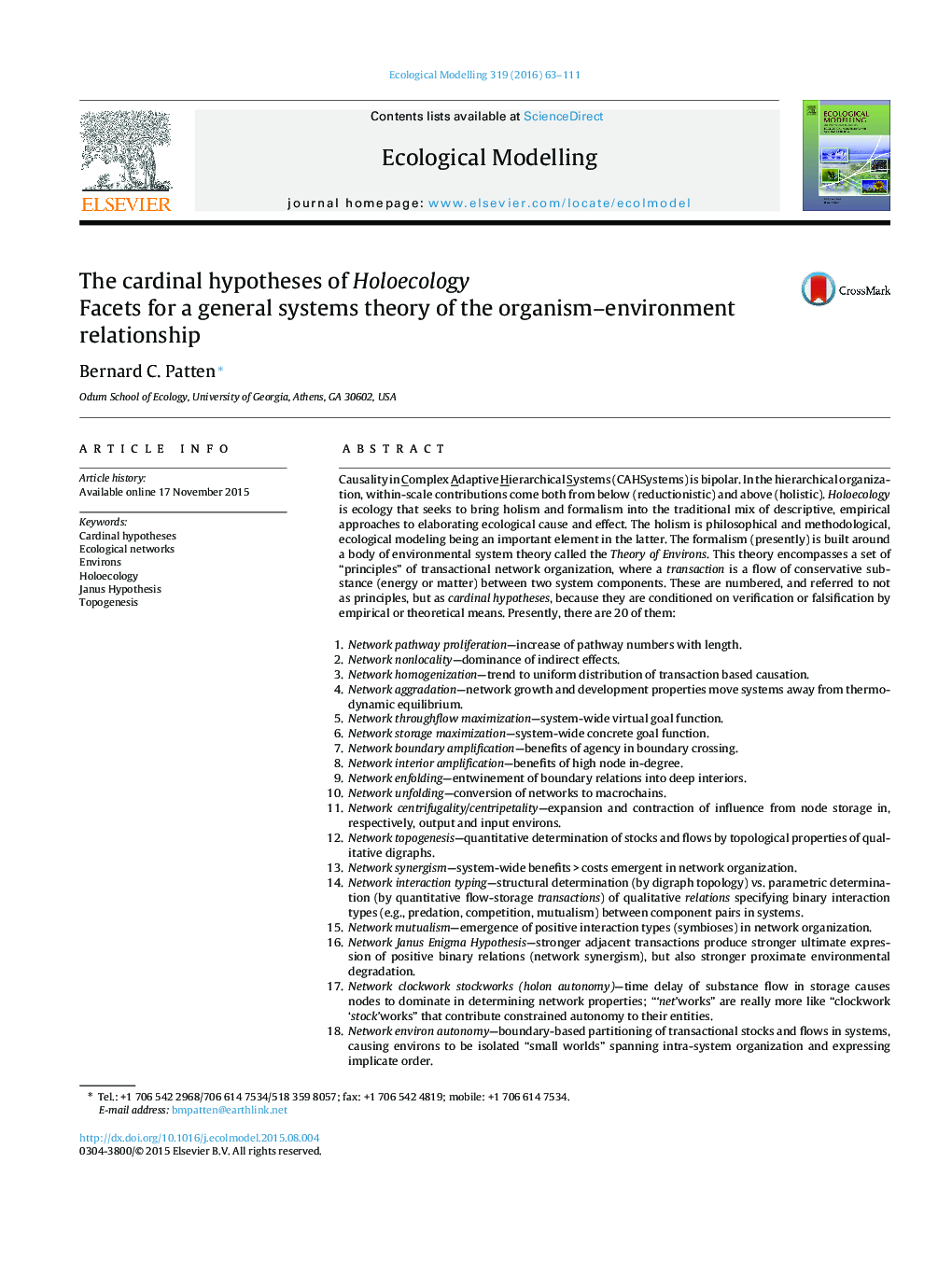| کد مقاله | کد نشریه | سال انتشار | مقاله انگلیسی | نسخه تمام متن |
|---|---|---|---|---|
| 4375612 | 1617428 | 2016 | 49 صفحه PDF | دانلود رایگان |
• Nature works by integrating reductionism and holism.
• Networks provide the means to this integration.
• Twenty network properties (cardinal hypotheses) clarify these means.
• Eight of these properties significantly revise the ecological worldview.
• To understand ecosystems will be to understand networks.
Causality in Complex Adaptive Hierarchical Systems (CAHSystems) is bipolar. In the hierarchical organization, within-scale contributions come both from below (reductionistic) and above (holistic). Holoecology is ecology that seeks to bring holism and formalism into the traditional mix of descriptive, empirical approaches to elaborating ecological cause and effect. The holism is philosophical and methodological, ecological modeling being an important element in the latter. The formalism (presently) is built around a body of environmental system theory called the Theory of Environs. This theory encompasses a set of “principles” of transactional network organization, where a transaction is a flow of conservative substance (energy or matter) between two system components. These are numbered, and referred to not as principles, but as cardinal hypotheses, because they are conditioned on verification or falsification by empirical or theoretical means. Presently, there are 20 of them:1.Network pathway proliferation—increase of pathway numbers with length.2.Network nonlocality—dominance of indirect effects.3.Network homogenization—trend to uniform distribution of transaction based causation.4.Network aggradation—network growth and development properties move systems away from thermodynamic equilibrium.5.Network throughflow maximization—system-wide virtual goal function.6.Network storage maximization—system-wide concrete goal function.7.Network boundary amplification—benefits of agency in boundary crossing.8.Network interior amplification—benefits of high node in-degree.9.Network enfolding—entwinement of boundary relations into deep interiors.10.Network unfolding—conversion of networks to macrochains.11.Network centrifugality/centripetality—expansion and contraction of influence from node storage in, respectively, output and input environs.12.Network topogenesis—quantitative determination of stocks and flows by topological properties of qualitative digraphs.13.Network synergism—system-wide benefits > costs emergent in network organization.14.Network interaction typing—structural determination (by digraph topology) vs. parametric determination (by quantitative flow-storage transactions) of qualitative relations specifying binary interaction types (e.g., predation, competition, mutualism) between component pairs in systems.15.Network mutualism—emergence of positive interaction types (symbioses) in network organization.16.Network Janus Enigma Hypothesis—stronger adjacent transactions produce stronger ultimate expression of positive binary relations (network synergism), but also stronger proximate environmental degradation.17.Network clockwork stockworks (holon autonomy)—time delay of substance flow in storage causes nodes to dominate in determining network properties; “‘net’works” are really more like “clockwork ‘stock’works” that contribute constrained autonomy to their entities.18.Network environ autonomy—boundary-based partitioning of transactional stocks and flows in systems, causing environs to be isolated “small worlds” spanning intra-system organization and expressing implicate order.19.Network distributed control—Expression among system components of distributed (indirect, decentralized, or remote) control at a network distance.20.Network ecogenetic coevolution—system-wide coevolution of mutually implicated parts and wholes to achieve and sustain systemic coherence and life.These hypotheses are grouped into sections by shared affinities. Eight of them are identified as having special potential to: transform ecology into a systems science that integrates bipolar causality; unify the reductive and holistic modes of science; and shift the ecological worldview more towards holism.
Journal: Ecological Modelling - Volume 319, 10 January 2016, Pages 63–111
